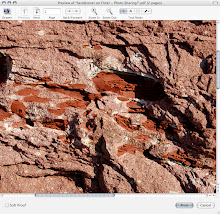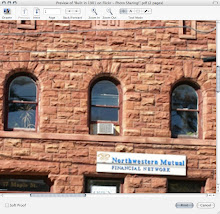over the motel there’s a near slope just beyond the edge
where people funnel into a trailhead
a gildedness
an allure beyond the dull green of the motel color
from the forest ranger’s uniform the familiar aesthetic
that slope not taken for a Tuscan influence
the dry creeks’ confluence on the other side of town
Thursday, February 7, 2008
Saturday, February 2, 2008
In Boulder in the mid 20th Century Boulder businesses did something that was fashionable in certain parts of the country; I believe concentrated in Western states. They covered up the fronts of their stone buildings with painted corrugated metal, completely obliterating from view the 19th Century stone constructions. My guess is there was a strong impulse to do this as a cover-up in the West. The Western states went through a period in the first two decades of that century of a stark rethinking, and sought to separate their identities from their lawless troubled beginnings. In Boulder by the early 1960s the corrugated covering of the buildings had deteriorated with the downtown district's decline. Businesses had closed, and business names had come off, leaving monotone colored metal smudged and in decay. In the 1970s Boulder began a renewal. The metal coverings were taken off. The sandstone of the buildings was revealed after several decades of being hidden. Boulder introduced a pedestrian walking mall, one of the most charming in the country, in 1976, which passes through the dark brown sandstone... In my hometown there was no such history of corrugated metal, and the sandstone buildings, which were of similar design as Boulder, remained fully in view. The early 1970s, unlike for Boulder, was not good for Potsdam. Urban renewal and a local political scandal involving it led to a block of downtown buildings being torn down entirely. The space where the businesses had been located remained a dirt and gravel parking lot through the 70s and well into the 80s.
Thursday, January 31, 2008
Reading a little book put out years ago by the Potsdam Museum, I learn that there were two sandstone quarries of Potsdam, and several more up and down on both sides of the Raquette River. The two quarries were flooded in 1922 when a dam above Sugar Island was built. Geologists named the stone Potsdam because it was first quarried in Potsdam and geologists went to Potsdam to study the rock between 1838 and 1842. The Upper Cambrian which underlies a large portion of the US is known to geologists as the Potsdamian.
The Potsdamian is only exposed close enough to be quarried in a few locations in North America because of the depth of the Cambrian. It's also prominent in localities of the Upper Peninsula of Michigan which have a close resemblance to the Village of Potsdam. Marquette Michigan is a beautiful old sandstone town along Lake Superior and is also a university town.
The Potsdamian is only exposed close enough to be quarried in a few locations in North America because of the depth of the Cambrian. It's also prominent in localities of the Upper Peninsula of Michigan which have a close resemblance to the Village of Potsdam. Marquette Michigan is a beautiful old sandstone town along Lake Superior and is also a university town.
Lately I've been walking from my apartment early in the mornings into the downtown area to Saxy's Coffeehouse at 10th and Tom's Way in Boulder. The sandstone I walk past is light brown and must break off in layers. That way it is used it gives a layering effect.
It is rare in Boulder for the buildings to use a red sandstone. There is red sandstone in the rocks that are in the soil here, and I don't know why they were not quarried and used in building much.
I've learned that the red sandstone here is in the Pennsylvanian Formation, and is called The Fountain Formation, and contains a lot of feldspar.
It is rare in Boulder for the buildings to use a red sandstone. There is red sandstone in the rocks that are in the soil here, and I don't know why they were not quarried and used in building much.
I've learned that the red sandstone here is in the Pennsylvanian Formation, and is called The Fountain Formation, and contains a lot of feldspar.
Subscribe to:
Comments (Atom)





